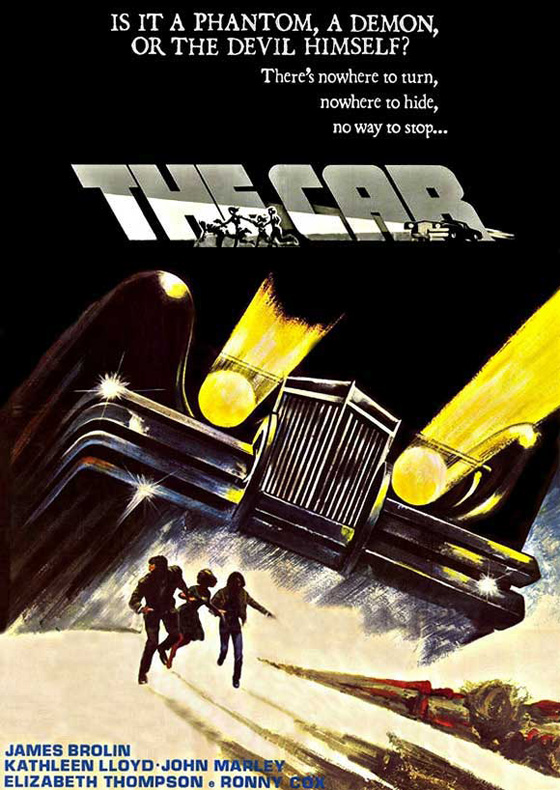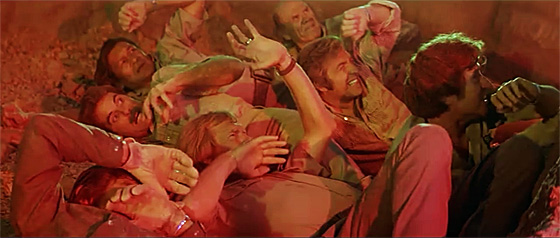
First there was Duel, Steven Spielberg’s 1971 TV-movie about man vs. truck. Then came Jaws (1975), which Spielberg says he accepted partly because of the parallels with Duel; he even reused the same “roar” for the shark’s death that he used for the destruction of the evil truck in the prior film. In the wake of Jaws‘ phenomenal success, a number of rip-offs were hastily made, including Tintorera (1977), Piranha (1978), and the notorious Great White (1981), which Universal Pictures successfully sued to have removed from the market. But Universal had already produced a rip-off of their own. Before Jaws 2 (1978) hit drive-ins, Universal gave us The Car (1977), which closely copies the plot of Jaws, with the difference being that the rogue killer is a car possessed by a demon. Despite the added layer of the supernatural, the studio had essentially reverted Jaws back to Duel, bringing the concept full circle, albeit in the dopiest way possible. The film was not directed by Steven Spielberg, but by Elliot Silverstein, a name that seems to indicate Spielberg’s evil twin. (Journeyman director Silverstein is best known for Cat Ballou and A Man Called Horse, but was just coming off Nightmare Honeymoon.)
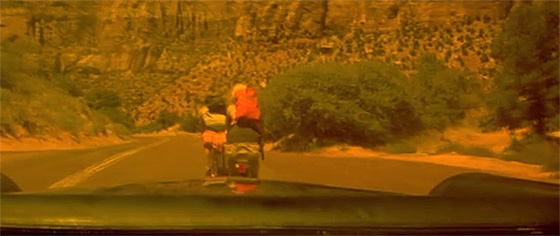
Filmed in Car-O-Vision: the Car stalks its first victims, a teenage couple biking down a Utah highway.
The Car opens first with a quote from Satanic Bible author Anton LaVey, which seems to align the film with The Devil’s Rain (1975); we now have learned that the Devil’s chief agents of destruction are rain and automobiles. But after the titles, we follow a young, giggling couple as they bike innocently along an empty road in the mountains of Utah. As with the skinny-dipper in Jaws, the two teens become the first victims of the Car, which is not seen – never show your monster too soon – but rather experienced through its own “eyes,” a yellowish-orange Car-O-Vision, as it runs the two teens down, causing them to go careening off a steep bridge and into a canyon. We then meet our protagonist, sheriff’s deputy Wade Parent, played by James Brolin, who was between a recurring role on Marcus Welby, M.D. and a starring turn in The Amityville Horror (1979). While Jaws established a warm, understated, believable rapport between Chief Brody and his wife, The Car introduces Wade and his schoolteacher girlfriend Lauren (Kathleen Lloyd of The Missouri Breaks) with out-of-tune warbling, chases around the bed, James Cagney impressions, and testicle-squeezing.
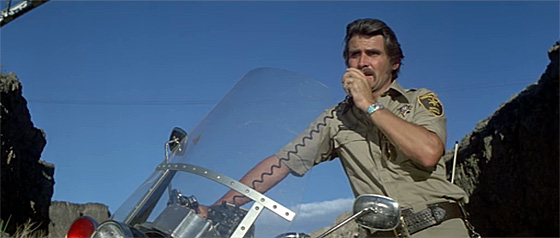
James Brolin as officer Wade Parent.
The Car’s second murder involves stalking and running over four times a hitchhiker with a French horn. We know it’s four times because when the witness describes it to the sheriff (John Marley) and his deputies, they have him repeat the fact again and again while they stare at him incredulously. Then, greatly disturbed, they study the severely bent French horn. “We’ve got a crazy on our hands,” the sheriff says. But the witness can’t describe the car; he only seems fairly certain that it was a two-door. Surely the film’s editing left the man confused. The killings continue, and Wade asks that the local parade be cancelled. But the message is never delivered, and “suspense” is built while we see the high school band setting up to march down a dusty road, led by Wade’s girlfriend. Then a fell wind whips through the parade, and the kids seem to sense that evil is coming, such that when we finally see a black Lincoln Continental Mark III about a mile away coming toward them, everyone immediately assumes it is coming to kill them, and they scream and run. Down the road, of course, not off it; that wouldn’t be fair to the Car.
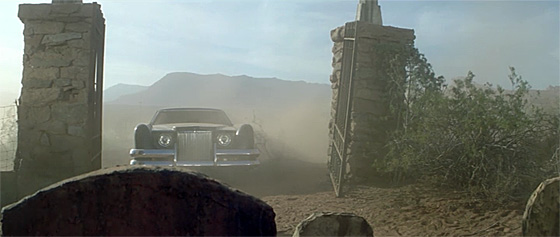
The Car refuses to cross hallowed ground.
Just in time, Lauren leads the kids into a cemetery, where for some reason they think they’ll be safe. But this proves correct: for the Car took the on-ramp out of Hell, and cannot cross hallowed ground. While Lauren hurls entirely unnecessary personal insults, the Car spins in circles and honks and fumes in frustration before finally departing. The police establish a blockade. After one officer is shoved off a cliff by the Car, Wade gets on the radio and orders, “We can’t let him through no matter what.” “Yeah,” another officer answers, “see Utah and die!” Having lived in the state for two years of my life, I sympathize. But as the Car approaches the two cop cars that are blocking both lanes in their game of chicken, the Car flips suddenly on its side, rolls, smashes into both in a fireball of an explosion, and then emerges unharmed without any apparent check in speed. So indestructible is the Car that when Wade confronts it, he fires rounds into its body and its windshield and nothing happens, which I would guess is the cheapest special effect in the entire film. As Wade approaches the car door, he realizes it has no handle (the Devil’s work). The door opens suddenly, knocks Wade down, and the Car drives off.
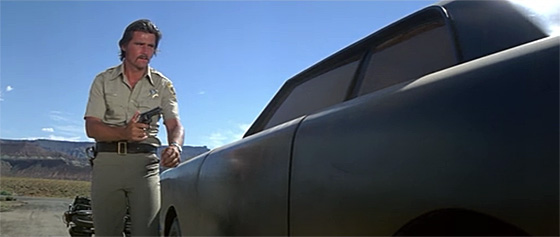
Wade approaches the Car.
Foreshadowing Jaws: The Revenge (1987), the Car has a memory and a desire for revenge. While it doesn’t care much about Wade – other than the need to humiliate him by knocking him down with its door – it took those insults from Wade’s girlfriend quite seriously. So the Car follows Lauren home, and then smashes a path straight through her house, killing her in the process. Wade, now obsessed with destroying the demonic creature, engages in a Duel™ with the Car while riding his motorcycle. Finally he spurs the Car to charge him, dives out of the way, and watches it plummet off a steep cliff. His fellow officers detonate dynamite, and the Car is buried below a mountain of rock – but not before we see its true face in the fire erupting from the canyon, a hideous demonic face before which the men cower in fear. Then they stand upon the cliff’s edge and bathe in the symbolism of the rising sun.
Ronny Cox of Robocop (1987) fame plays one of the deputies. The music is by Leonard Rosenman, who scored another Satanic road chase movie, Race with the Devil (1975). His score here sounds almost exactly like his work on Ralph Bakshi’s Lord of the Rings (1978). The Car was built by George Barris, who built the Batmobile for the Batman TV series and worked on The Dukes of Hazzard and Knight Rider. To me it just looks like a brick-shaped black car.
